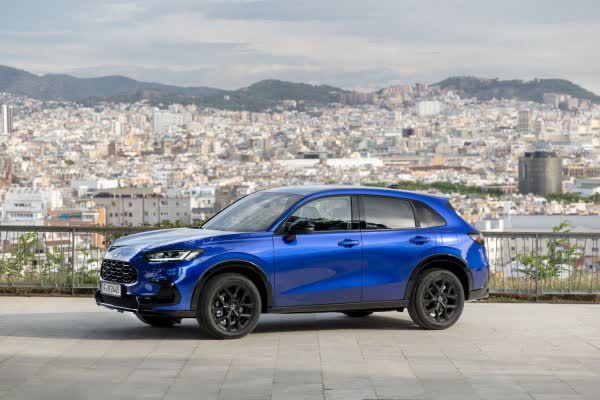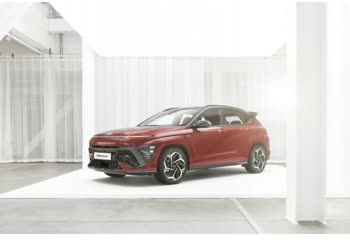Everything you need to know about specifications and performance - Honda ZR-V ZR-V 2023 - 2.0 (184 Hp) e:HEV e-CVT

Overview:
What is the engine capacity of a Honda ZR-V 2023?
The engine capacity of the Honda ZR-V 2023 is 1993 cm.
Honda ZR-V 2023 How many horsepower?
The engine power of the Honda ZR-V 2023 is 141 Hp @ 6000 rpm..
What is the Honda ZR-V 2023 engine?
Honda ZR-V 2023 engine is LFC. (Click to see other cars using the same engine)
How powerful is the electrical system in the Honda ZR-V 2023?
The power of the electrical system in the Honda ZR-V 2023 is 184 Hp @ 5000-6000 rpm. hp.
How much gasoline does a Honda ZR-V 2023 consume?
The Honda ZR-V 2023 consumes 4.5 liters of gasoline per 100 km
General:
Brand: Honda
Model: ZR-V
Generation: ZR-V
Modification (Engine): 2.0 (184 Hp) e:HEV e-CVT
Start of production: April, 2023
End of production:
Powertrain Architecture: FHEV (Full Hybrid Electric Vehicle)
Body type: SUV, Crossover
Seats: 5
Doors: 5
Engine:
Engine systems: Start & Stop System
Power: 141 hp @ 6000 rpm.
Power per litre: 70.7 hp/l
Torque: 182 nm @ 4500 rpm.
Engine Model/Code: LFC
Engine displacement: 1993 cm
Number of cylinders: 4
Engine configuration: Inline
Number of valves per cylinder: 4
Fuel injection system: Direct injection
Engine aspiration: Naturally aspirated Engine
Valvetrain: DOHC
Engine oil capacity: 4 l
Coolant: 5.72 l
Engine layout: Front, Transverse
Cylinder Bore: 81 mm
Piston Stroke: 96.7 mm
Compression ratio: 13.9
Performance:
Fuel Type: Petrol (Gasoline)
Fuel consumption (economy) - urban: 5.1-5.2 l/100 km
Fuel consumption (economy) - extra urban: 4.6 l/100 km
Fuel consumption (economy) - urban (WLTC): 5.1-5.2 l/100 km
Fuel consumption (economy) - extra urban (WLTC): 4.6 l/100 km
Fuel consumption (economy) - combined: 4.5 l/100 km
Fuel consumption (economy) - combined (WLTC): 4.5 l/100 km
Weight-to-power ratio: 8.5 kg/Hp, 117.9 Hp/tonne
Weight-to-torque ratio: 5 kg/Nm, 201.9 Nm/tonne
Electric system:
Battery technology: Lithium-ion (Li-Ion)
Battery location: Under the rear seats
System power: 184 hp @ 5000-6000 rpm.
System torque: 315 nm @ 0-2000 rpm.
Electric motor power: 184 hp @ 5000-6000 rpm.
Electric motor Torque: 315 nm @ 0-2000 rpm.
Electric motor location: Integrated into the transmission
Electric motor type: Synchronous
Electric motor model/code: H4
Space:
Kerb Weight: 1560-1580 kg
Fuel tank capacity: 57 l
dimensions:
Length: 4570 mm
Width: 1840 mm
Height: 1620 mm
wheelbase: 2655 mm
Front track: 1590 mm
Rear (Back) track: 1605 mm
Ride height (ground clearance): 190 mm
Minimum turning circle (turning diameter): 11 m
Powertrain, Suspension and Brakes:
Drivetrain Architecture: The Internal combustion Engine (ICE) and electric motor drive the front wheels of the car with the ability to work in full electric or mixed mode.
Drive wheel: Front wheel drive
Number of gears and type of gearbox: automatic transmission e-CVT
Front brakes: Disc
Rear brakes: Disc
Assisting systems: ABS (Anti-lock braking system)
Steering type: Steering rack and pinion
Power steering: Electric Steering
Tires size: 225/55 R18 98H
Wheel rims size: 7.0J x 18
Front suspension: Independent type McPherson
Rear suspension: Independent multi-link suspension
See also

Same production year and almost the same engine capacity.
Its production began in 2023 until Now
Write a comment